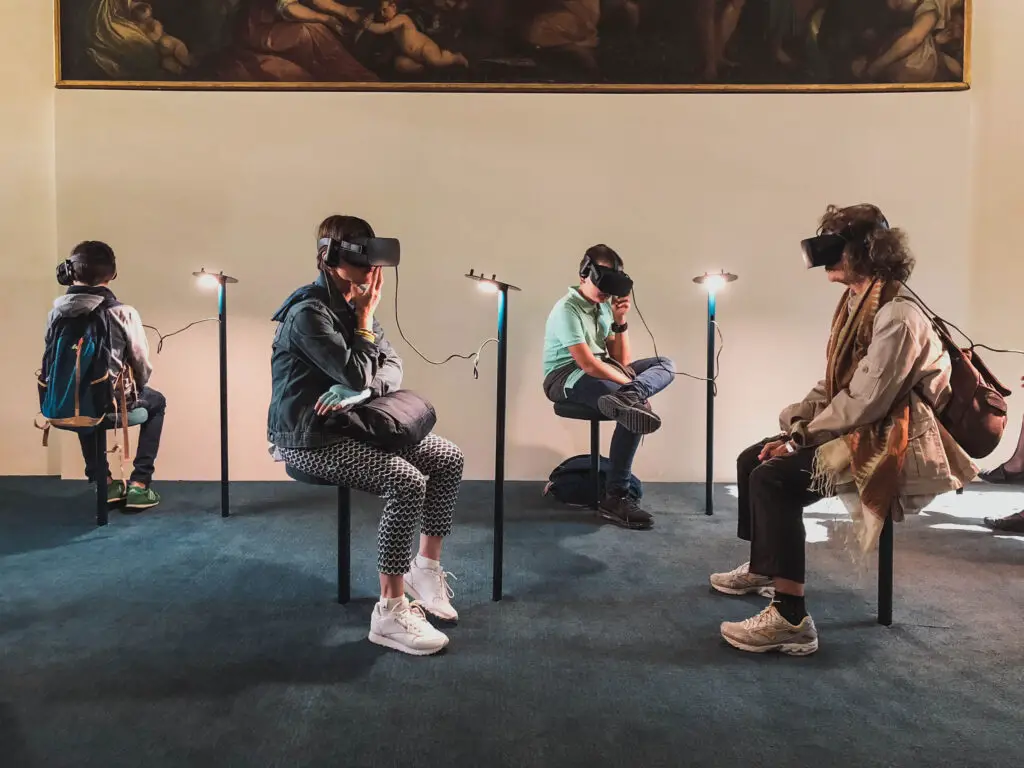Who hasn’t dreamed of waking up one day magically a few pounds lighter, or discovering a surprise deposit in your bank account, or, if you’re a language learner – miraculously realizing that overnight you somehow learned a ton of new foreign vocabulary words in your sleep.
The good news is that as challenging as it may seem, learning a new language is within everyone’s grasp. It just takes some patience, a positive attitude, and some methods that you enjoy (enjoyment can make all the difference!). With that in mind, I’ve put together a list of 75 ways to learn foreign language vocabulary, to provide a range of techniques and tools to suit anyone’s learning style and preferences.
What are the best ways to learn a foreign language?
In this post, you’ll find many approaches, from traditional methods to innovative digital tools (like our very own WordTap game), and even a few unconventional hacks. Don’t let it overwhelm you. It may be long, but the goal is to offer a wide variety of options.
There’s no one best way to learn new vocabulary. The very best way is the way that you like the best. Just pick the ones that you like and ignore the rest. So get comfortable, and let’s dive in!
1. Flashcards
Flashcards are a classic language learning tool that can help you memorize foreign vocabulary quickly and effectively. Although there are many online, premade flashcard tools, they are easy to make too – all you need is a pen, some small squares of paper or cards, and words. By writing a word in your target language on one side of a card and the definition in your native language on the other, you can test yourself whenever you have a chance. Once you know a word, you can take that card out of the deck. This method has been used since at least the early 1800s, and remains in use today because it works. Tips and popular flashcard tools.
2. Spaced repetition
Spaced repetition is a learning technique that involves reviewing material at increasing intervals to improve long-term retention. You can use spaced repetition software to help you memorize new vocabulary more effectively. Several other methods listed below incorporate this method as well. Check out this post for a closer look.
3. Label objects
Labeling objects around your home or office with their corresponding foreign language words can help you reinforce your vocabulary in a practical way. For example, you could label your desk “escritorio” in Spanish. Sticky notes work great for this!
4. Mnemonics
Mnemonics involves creating a mental image to help you remember something. For example, you might associate the sound of a new word in the foreign vocabulary with a familiar image or word in your own language to help you remember it. Let’s say you’re trying to learn the Spanish word for “bread,” which is “pan.” You could create a mental image of a loaf of bread sitting inside a frying pan. The image of the bread and pan together creates an association in your mind that helps you remember the word “pan” more easily. By creating vivid and memorable associations like this, you can use mnemonics to make it easier to learn any foreign vocabulary. This post unlocks the power of mnemonics.
5. Language exchange
A language exchange involves finding a partner who speaks the language you’re learning and is interested in practicing your native language. Websites like italki or Tandem, provide an opportunity to practice your language skills with native speakers from around the world.

6. AI chatbots
AI-powered chatbots, like our Free AI Language Tutor, offer a dynamic way to enhance your language skills through conversation and immediate feedback on vocabulary, and stand out for their ability to simulate real-life interactions. Check out our comprehensive guide: AI for Language Learning, or see how I use ChatGPT everyday with my language students here.
7. Shadowing
Shadowing involves listening to a native speaker or a recording in the language you’re learning and repeating what you hear immediately. This technique can help you improve your pronunciation, fluency, and your vocabulary. It’s called shadowing because you’re essentially “shadowing” the speaker, trying to match their speed and intonation as closely as possible. By doing this, you can train your brain to process the language more quickly and naturally. Explore the power of shadowing.
8. Word of the day
Many language learning apps and websites offer a “word of the day” feature, which gives you a new foreign language word to learn each day. This is a great way to build your vocabulary gradually over time.
9. Songs
Listening to songs in the foreign language you’re learning and trying to understand the lyrics can be a fun and effective way to build your vocabulary. You can look up the lyrics online and try to translate them yourself. Find more details here.
10. Movies and TV shows
Watching TV shows and movies in the language you’re learning can help you pick up new vocabulary and improve your listening skills. You can begin with subtitles in your language to help you understand what’s being said, then move on to subtitles in the target language to read and follow along, and slowly decrease the percentage of viewing time with subtitles at all. Over time you’ll be surprised (and proud!) to discover that you understand without them.
11. Podcasts
Listening to podcasts in the foreign language you’re learning can help you improve your listening skills and pick up new vocabulary. At first you may want to look for podcasts that are designed specifically for language learners.
12. Reading Out Loud
Reading out loud is a technique that’s near and dear to my heart. It helped me immensely when I learned my second language. This active learning approach engages multiple senses and as a result makes vocabulary retention more effective. Regular practice also improves reading and speaking fluency. Any text will do, but if conversational skills are what you’re after I would pick something that’s written in the first person. I love TED lectures for this technique, since each lecture comes with a transcript. Or if you want something more tailor made, you can ask ChatGPT for a customized text, or use WordTap’s custom text creation tool on this page.
13. Word Roots
Learning the root words of the foreign language you’re learning can be a helpful tool in understanding the meaning of new vocabulary words. When learning English, for example, if you know that the Latin root “spec” means “to see,” then you can more easily understand and remember words like “spectacle,” “inspector,” and “prospect.”
14. Prefixes and Suffixes:
Understanding prefixes and suffixes in a foreign language enhances your vocabulary and comprehension. Prefixes and suffixes, added at the beginning or end of a word, change its meaning or function. For instance, in English, the prefix “un-” means “not,” making “happy” into “unhappy,” and the suffix “-ness” turns the adjectives “happy” into the noun “happiness.” Recognizing these patterns helps you deduce meanings of new words and boosts your language confidence.

15. Comic strips
Reading comics can be a fun way to learn new vocabulary in a foreign language. Comics often use simple language and lots of pictures, making them easy to understand even if you’re not familiar with every word.
16. Word games
Word games are a fun and engaging way to practice your vocabulary, improve your word recall skills and help you learn new words and reinforce your understanding of their meaning. For example word association games, matching games, wordle type games, crossword puzzles, word searches, Scrabble and WordTap.
17. News articles
Reading news articles in the language you’re learning can help you stay up-to-date on current events while also improving your vocabulary and reading comprehension. You can find articles online or in print, and choose topics that interest you to make the learning process more engaging. Many online sites offer news for language learners.
18. Social Media
Social media can be a great way to practice your foreign language skills and build your vocabulary. You can follow accounts in the language you’re learning, participate in conversations with native speakers, and even post your own content to practice writing. In addition, Social media challenges, such as the #100DaysofLanguageLearning challenge, can encourage you and your circle of friends to practice a language for a set period of time and share your progress and experiences, building a sense of community and motivation.
19. Sentence building
Instead of just memorizing individual vocabulary words, you can learn them in the context of full sentences. This will help you understand the meaning of the word better. Start with simple sentences and gradually build up to more complex ones as your language skills improve.
20. Diagramming Sentences
Though diagramming sentences may not be traditionally seen as a method for learning vocabulary, any exposure to your target language is an opportunity to learn new vocabulary. This method exposes you to new words and phrases in context and, as an added benefit, helps you better understand the structure and grammar of the language you’re learning. Diagramming sentences can be seen as a linguistic puzzle, making your learning process fun and challenging. You’ll be amazed at how your vocabulary expands as you dissect and understand each part of a sentence. The website “Grammar Revolution” is a great place to learn more about it.
21. Online forums
Participating in online language learning forums, such as Reddit’s r/languagelearning or the Duolingo forums, provide a supportive learning community. Interacting with other learners can give you feedback and support, as well as insights into different learning techniques and resources.
22. Immersion
Immersion is a technique that involves surrounding yourself with the foreign language you’re learning as much as possible. This could mean listening to music, watching TV shows or movies, joining a club or finding a community in your city. By immersing yourself in the language, you can improve your listening and speaking skills, as well as pick up new vocabulary and grammar naturally.

23. Virtual Reality Language Immersion
Virtual reality technology provides an immersive language learning experience. This new and exciting method can help learners develop more authentic and natural language skills while having an awesome technological experience. Learn how to get started.
24. The Goldlist Method
The Goldlist Method involves writing new foreign vocabulary words down in a notebook, then reviewing the list every few weeks to see which words you remember. If you remember a word, you transfer it to a new list; if you don’t remember it, you leave it on the original list. This method is based on the idea of spaced repetition, and that by focusing on the words you don’t remember, you can improve your retention over time.
25. Games
Playing games can be a fun way to learn new vocabulary in a foreign language. It doesn’t have to be only word games, it can be any game, as long as you’re playing in your target language. You can play trivia games, video games, charades, Pictionary and more.
26. Online Role Playing Games (RPGs)
Playing online role playing games in the foreign language you’re learning can provide a fun and interactive way to practice your language skills while also socializing with other players. By communicating in the target language you can improve your language skills, as well as build friendships and a sense of community.
27. YouTube
YouTube is a great free tool for language learners since you can find videos in almost any language. Besides the many teachers who teach on YouTube, you can watch videos in your target language to practice listening and pick up new vocabulary, and even create your own content to practice speaking.
28. The 80/20 Rule
The 80/20 Rule, also known as the Pareto Principle, states that 80% of your results come from 20% of your effort. In language learning, this means focusing on the most commonly used words and phrases first, since they make up the majority of the language you’ll encounter in everyday conversation. By mastering these high-frequency words, you can build a strong foundation for further learning.
29. The Memory Palace
The Memory Palace is a technique that involves creating a mental image of a familiar location, such as your home or office, and then associating new vocabulary words with different objects or locations within that space. By creating a vivid mental image of the word and its association, you can improve your retention and recall of the word over time.
30. Visual aids
Using visual aids such as pictures, diagrams, and mind maps can help you associate new foreign vocabulary words with visual representations. This can make it easier to remember the words later on.
31. Listen to audio
Listening to audio recordings of native speakers can help you better understand the correct pronunciation and accent for a language. This is especially useful when learning languages with unfamiliar sounds or tones.

32. Books
Reading books in a foreign language can be a little intimidating, but it can also be very rewarding and is a great way to improve your vocabulary. It’s important to choose books that match your language level, interests, and goals. You can start with children’s books, or simplified versions of classic novels, and gradually work your way up to more complex texts. The great thing about books is that authors (as does everyone) have a go-to set of words that are used over and over again, so reading an entire book will give you the repetition that is so effective in language learning.
33. Record your voice
You can use the voice recorder app on your phone or computer to record your voice as you practice speaking the language you’re learning. Hearing yourself can at times be uncomfortable, but it can really help you identify areas where you need improvement, and help you track your progress as well.
34. Contextual Learning
Rather than memorizing individual words, this method focuses on learning how to use them in sentences and phrases. This helps you understand the meaning of the word more fully which will help you remember it more easily.
35. Word associations
Rather than memorizing individual words, this method focuses on learning how to use them in sentences and phrases. For example, let’s say you’re trying to learn the French word for “book,” which is “livre.” You might associate the word “livre” with the English word “library”. This helps you understand the meaning of the word more fully which will help you remember it more easily.
36. Thematic learning
Thematic learning involves focusing on a specific theme or topic, such as food, travel, or business, and learning related foreign vocabulary and grammar structures. This can help you build a strong foundation of knowledge in a specific area and make the learning process more engaging and relevant to your interests.
37. Fill-in-the-blank exercises
Fill-in-the-blank exercises involve completing sentences or paragraphs with missing words. By using context clues and your knowledge of grammar and vocabulary, you can improve your reading comprehension and reinforce your understanding of language usage.
38. Quiz yourself
Quizzing your foreign vocabulary words regularly can help reinforce your memory and improve your recall speed. It’s a simple yet effective way to monitor your progress and identify areas that need improvement. Self quizzing is an important element of active recall, one of the strategies I most frequently use in my teaching.
39. Language courses
Language courses are a structured and comprehensive method of language learning. By following a course syllabus and completing assignments, you can build a strong foundation of knowledge and skills in the language you’re learning with confidence.
40. Mind Mapping
Mind mapping involves creating a visual map of related ideas or concepts. You can use mind mapping to organize new vocabulary words into different categories or themes, and see the relationship between the words to remember them more effectively.

41. Practice with a partner
Practicing with a partner, be it friends or family members, can provide a social and collaborative language learning experience. By working together, you can practice your speaking and listening skills, as well as provide feedback and support for each other’s learning.
42. Color-coding
Color-coding foreign vocabulary words based on their part of speech in context can help visually reinforce your understanding of the individual words on a deeper level. For example, “light” can be a noun, a verb, an adjective, and an adverb depending on its function in the sentence. So by assigning different colors to the parts of speech as you read them, you can add depth and nuance to the learning process.
43. Collocations
Collocations are words that naturally “go together”. For example, you “do” the laundry, but you “make” the bed. There are adjective-noun pairs (e.g. “strong coffee,” “fast car”), and adverb-verb pairs (e.g. “run quickly,” “speak fluently”). Using collocations correctly can help you sound more fluent and natural. You can learn collocations through various methods, such as reading authentic texts, watching TV shows or movies, and using vocabulary lists or flashcards.
44. Set goals
Setting goals for your foreign language learning can help you stay motivated and focused, and track your progress over time. By setting realistic and achievable goals, such as learning a certain number of new foreign vocabulary words per week, or achieving a certain level of fluency by a specific date, you can make the learning process more tangible and rewarding.
45. Role-play
Role play involves acting out scenarios or situations in the language you’re learning. By taking on different roles and using the language in context, you can improve your fluency and confidence, as well as develop your cultural awareness and understanding.
46. Idioms and Slang
Incorporating idioms and slang into your vocabulary can be a great way to sound more natural and connect with locals, but it’s also challenging. Look for resources online that specifically focus on idioms and slang, and don’t be afraid to ask native speakers for help or clarification when you encounter unfamiliar expressions.
47. The Keyword Method
The Keyword Method involves associating new vocabulary words with keywords or mental images that are easy to remember. For example, if you’re learning the word “table” in Spanish, you might associate it with the keyword “tablón,” which sounds similar and means “plank.” By creating a mental image of a plank being used as a table, you can make the association more memorable and improve your retention of the word.
48. Synonyms and antonyms
Learning synonyms and antonyms expand your understanding of a word. Armed with an arsenal of synonyms and antonyms you’ll be able to express yourself in a more nuanced way than you could previously. One way to do this is to take a sentence (from the newspaper, or a book for example) and one by one see how many words you can replace while still retaining the meaning. To further enhance your synonym power and deepen your vocabulary knowledge through active learning, check out our comprehensive guide on using paraphrasing to boost your language skills: ‘Building Vocabulary Skills Through Paraphrasing.’

49. Cooking
Cooking in the foreign language you’re learning can be a fun and practical way to improve your language skills while also learning about the cuisine and culture of the people who speak the language. You can find recipes online or in cookbooks, and practice reading and following the instructions in the target language.
50. Chunking
Chunking is about learning groups of words together, rather than single vocabulary words. Remember those travel phrasebooks? Those are chunking in action – and they’ve been around forever because it’s a technique that works! This post explains chunking strategies in depth.
51. Translation exercises
Translation exercises involve translating texts or sentences from the language you’re learning into your native language, or vice versa. By doing so, you provide your brain with the opportunity to retrieve the word your looking for and strengthening its pathway. This technique also helps you practice flowing between the two languages.
52. Vocabulary notebook
Keeping a vocabulary notebook can help you organize and reinforce your learning, and track your progress over time. By recording new vocabulary words and their meaning, as well as example sentences and notes on usage, you can create a personalized reference tool to help you review and practice your vocabulary.
53. Word clouds
Word clouds are visual representations of word frequency or usage. By creating a word cloud for a specific topic or text in the language you’re learning, you can identify key vocabulary and reinforce your understanding of their meaning and usage.
54. Vocabulary lists
Creating your own foreign language vocabulary lists based on words that are important to you can help you stay motivated by serving your specific, immediate needs, be it for travel, work, or social situations. Using Wordtap can help you with that!
55. Watch TED Talks
TED Talks are a great resource for language learners, providing inspiring and informative talks on a wide range of topics. One great feature of the TED website is that below each video you have the option of reading the transcript, which is usually translated into many languages. It’s definitely worth checking out.
56. Pronunciation practice
Pronunciation practice isn’t only about sounding good, it’s also about confidence. Our brains tend to want to protect us from embarrassing ourselves and if it doesn’t think you’ll pronounce the word right it may block its recall just when you need it. By putting some effort into the correct pronunciation of new foreign vocabulary, you’re letting your brain know that you can do it, so that it will confidently supply you with the word when needed.
57. Watch foreign language news
Watching foreign language news broadcasts can be a challenging but rewarding way to improve your language skills. News broadcasts often use formal language and complex vocabulary, providing an opportunity to practice your listening and comprehension skills at an advanced level.

58. Travel
Traveling to a country where the language you’re learning is spoken can provide an immersive and rewarding language learning experience. By engaging with the culture and people who speak the language, you can improve your speaking and listening skills, as well as deepen your cultural understanding and awareness.
59. Public speaking
Public speaking in the language you’re learning can be an advanced and rewarding way to improve your fluency and confidence. By preparing and delivering speeches or presentations, you can practice your speaking skills in a structured and controlled environment, and receive feedback on your performance.
60. Group study sessions
Group study sessions provide a supportive and collaborative learning environment. By working together, you can reinforce your knowledge and build your confidence in using the foreign language you’re learning. Organize your own group study sessions with like minded friends and enjoy the social aspect as well.
61. The Pomodoro Technique
The Pomodoro Technique is a time management method that involves breaking work into short, focused intervals (usually 25 minutes) separated by brief breaks. You can use this technique to structure your language learning sessions, focusing on specific tasks such as vocabulary review or conversation practice for a set period of time, and then taking a break before continuing.
62. Scripted Dialogues
Scripted dialogues are pre-written conversations that you can use to practice your speaking and listening skills. By using scripted dialogues in your target language, you can focus on specific grammar and vocabulary points and practice your pronunciation and intonation.
63. Personalize learning
Personalizing your language learning experience can help you stay motivated and engaged, and tailor your learning to your individual needs and interests. This could involve choosing topics or materials that interest you, setting your own learning goals, or using different techniques and resources to suit your learning style.
64. Use a language tutor
A language tutor is a great way to get a personalized language learning experience. He or she can identify areas where you need improvement, provide immediate feedback to help you stay motivated and on track.
65. Foreign language pen pals
Finding a foreign language pen pal can provide a unique and engaging way to practice your writing and communication skills. By exchanging letters or emails with someone who speaks the language you’re learning, you can improve your vocabulary, grammar, and cultural understanding, as well as build a meaningful connection with someone from another culture.
66. Learn etymology
Etymology is the study of the origins and evolution of words. By learning about the etymology of words in the language you’re learning, you can deepen your understanding of their meaning and usage, as well as discover interesting connections between languages and cultures.
67. Audio courses
Audio courses are a popular and effective way to learn a language, especially for those who prefer to learn by listening. They typically include dialogues, exercises, and vocabulary lists, and can be used on-the-go or during commutes. Use audio language courses like Pimsleur or Michel Thomas.

68. Journaling
Journaling in the language you’re learning is a great way to build your vocabulary. As opposed to conversation, writing gives you time to think, which gives your brain practice in recalling the newly learned words you need. The important thing is not to get stuck on what to write about – just write!
69. Act out new words
Acting out new words can help you remember their meaning and usage more effectively. By using physical gestures and movements to represent the words, you can create strong associations and make them not only more memorable, but also fun. Even if it feels a little silly, believe it or not, that can actually be advantageous when it comes to learning something new.
70. Attend cultural events
Attending cultural events, such as festivals, concerts, or exhibitions, can provide a unique and immersive foreign language learning experience. By engaging with the culture and people who speak the language you’re learning, you can practice your listening and speaking skills, as well as learn more about the customs and traditions of the people who speak the language..
71. Illustrate new words
Do you like drawing? Then this method might be the one for you. Illustrating new words with pictures or diagrams can help you remember their meaning and usage more effectively. By creating visual associations with the words you’re learning, you can make them more memorable and engaging.
72. Foreign language blogs
Reading blogs in the language you’re learning can provide a wealth of information and insights into the culture and language of native speakers. You can find blogs on a wide range of topics, from travel to fashion to politics, and practice your reading comprehension and foreign vocabulary skills in the process.
73. Language learning websites
Foreign language learning websites, such as Duolingo, Babbel, or Memrise, can provide a structured and engaging approach to language learning. These websites often offer interactive exercises, games, and quizzes to help you learn vocabulary, grammar, and pronunciation.
74. Language apps
Language learning apps provide a variety of digital tools to facilitate the learning of vocabulary. These apps often incorporate some of the previously mentioned methods such as flashcards, and word games. all of which aim to make learning fun, engaging, and effective. With the convenience of mobile technology, language apps offer a flexible and accessible way to improve language skills and acquire new vocabulary on the go.
75. Consistency
Not exactly a method, but consistency is key when it comes to language learning. By practicing regularly, even if only for short periods of time, you can build a strong foundation of knowledge and reinforce your foreign language skills over time. It’s important to make language learning a habit and integrate it into your daily routine.
Does learning foreign vocabulary help you?
Learning vocabulary is a crucial part of the language learning journey. By expanding your vocabulary, you can express yourself more precisely and fluently, and understand more of what you hear or read in your target language. Vocabulary is the building blocks of language, and the more blocks you have, the more you can construct. Without a strong vocabulary, you may struggle to communicate effectively, even if your grammar is correct.
More importantly, learning vocabulary can be a motivating and rewarding experience. As you learn new words and phrases, you can immediately put them into practice and see the results. Overall, focusing on vocabulary is an essential part of any language learning journey, and can greatly enhance your communication skills in today’s world.
Conclusion
This blog post has presented 75 effective ways to learn foreign vocabulary, ranging from simple techniques such as word association to more complex methods like shadowing. Learning new words can be challenging but having the right strategies can make all the difference in mastering a language.
Try some today and become a master of vocabulary!




